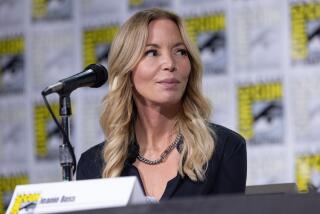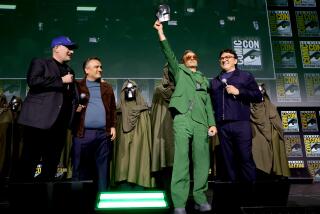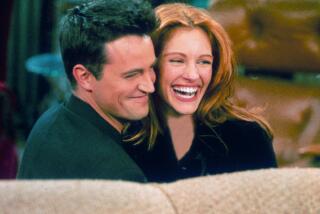Wrestlers tag-team from ring to film
The day after one of the biggest professional wrestling events of the year, Randy Orton, the heavily tattooed, frequently sneering, seven-time World Wrestling Entertainment champion, is standing in the bowels of the Staples Center confessing a lack of self-confidence. Not about his most recent performance in the ring, where he administered the requisite body slams, clotheslines and backbreakers to his rival, Irish wrestler Sheamus. This is about channeling his inner Humphrey Bogart more than his inner Hulk Hogan.
“I can’t say I’m confident in my abilities as an actor,” Orton says tentatively, describing his experience as a dramatic performer in the 2011 movie “That’s What I Am,” a period coming-of-age story with Amy Madigan and Ed Harris in which Orton plays a father caught up in a school controversy. “I thought doing this for 10 years would give me an edge, but it hasn’t.”
Many a wrestler has attempted the leap from the ring to the silver screen. Mike Mazurki moved to midcentury noir pictures, Jesse Ventura and Rowdy Roddy Piper popped up in action movies in the 1980s and ‘90s and Dwayne “The Rock” Johnson has starred in action movies such as “The Scorpion King” and broad comedies, including “The Tooth Fairy.”
Orton’s shift is different. It’s part of a far larger transformation being orchestrated by WWE chairman and CEO Vince McMahon that may be either pure marketing genius or simple hubris. The wrestling impresario is taking the personalities from his weekly fight shows — where they can regularly be seen diving off ropes, drop-kicking mouthy opponents and goading a bloodthirsty crowd — and trying to mold them into subtle thespians.
Unlike the usual switch to big action vehicles or broad comedies, he’s hoping the stars can pull off roles in gentle comedies, dramas and police procedurals. In other words, he’s hoping they can act. “When you create global superstars and part of their skill is their acting skills, this is a natural extension,” McMahon said.
McMahon has created a film division of WWE, with a slate of more than half a dozen pictures distributed through Samuel Goldwyn Films, that doesn’t go for a big concept built around star power. Instead, the movies tell smaller stories with experienced actors such as Harris, Madigan, Patricia Clarkson and Danny Glover, and slot the wrestlers in as part of an ensemble, hoping their acting can carry the day.
Arriving in theaters Friday is “Knucklehead,” starring 400-pound Big Show as a gentle giant who has gotten to his mid-30s without having lived outside of a Catholic orphanage. Big Show (real name: Paul Wight) is not new to the big screen; the 38-year-old with a smooth scalp and dark, thick goatee has had bit parts in comedies such as “The Waterboy” and “MacGruber,” where he essentially riffed on his in-ring persona.
But this is his first full-fledged role as someone entirely fictional, and as he sits on his private tour bus in the Staples parking lot the night before SummerSlam, he finds himself in a place of gooey introspection that might make Mark Ruffalo proud. “Playing a character outside the ring allowed me to free some things inside me,” Show said, clasping his oven-mitt-size hands together nervously. “When you express that much emotional nakedness or vulnerability, it unlocks a lot of change in you.”
“Knucklehead” follows September’s “Legendary,” in which John Cena, the clean-living face of the WWE who previously acted in the blow-’em-up “The Marine,” took on his first dramatic role, as an estranged son of a woman played by Oscar nominee Clarkson. (With largely weak reviews and a minuscule $200,000 in box office, it was an unquestionable disappointment, although it’s expected to recoup some of its investment on DVD.)
And the long-haired WWE villain Edge (real name: Adam Copeland; claim to fame: the Edgecator, a move in which legs and ankles are twisted and held in painful positions), has been drafted to play a laid-back cop in the comedy-drama “Bending the Rules,” a role more in keeping with his real-life surfer-boy personality than his manic in-ring one.
“One of the misconceptions when people meet wrestlers is that they think it’s all big hair and underwear and rah-rah. I don’t think that anyone believes we might read a book every two days, which I try to do,” said Edge, a thoughtful Canadian with a gentle manner. “They don’t think that we might possibly be intelligent.”
The job of wrangling persuasive performances from men accustomed to spending extensive amounts of time drop-kicking people in spandex falls to Mike Pavone, head of WWE Studios and director of “That’s What I Am.”
“I know that some people might be skeptical. They say, ‘You wouldn’t take Brad Pitt and drop him in the middle of a wrestling ring and expect him to do a good job,’” he said. “But I’m not starting at ground zero here. These are natural performers. I’m taking people who are a six or a seven and just trying to get them up a couple of numbers.”
To do that, Pavone has leaned on film and television veterans. On “Knucklehead,” the actor Mark Feuerstein (star of the NBC medical dramedy “Royal Pains”) took Show under his wing.
“I remember coming back to the bus one day after shooting and just chilling, and then all of a sudden I start crying. And I’m not a man who cries easily,” Show notes, saying the part of a large, misunderstood man reminded him of his own life. “I thought something was wrong. I called Mark and he came right over and told me that I’d had a breakthrough.”
Orton, meanwhile, has flown to Los Angeles several times to take acting lessons with Steven Anderson, who runs the school Actorworks. Orton acknowledges that it’s been a difficult education.
“The first few times I was on set I’d hear everyone in the crew saying, ‘Shh, shh, quiet, quiet, quiet.’ And I thought, ‘Why do we have to be so quiet?’ I thought it was the audio. Then I realized that the actors were getting into character,” Orton adds.
Among the biggest challenges for wrestlers is scaling down their performance from the bombast of a stadium to the intimacy of a film camera. “In the ring you want every one of the 80,000 people in the building to know what you’re feeling,” Orton says. “On a movie set every expression you make is going to get picked up times 10. They kept having to dial me back.”
Show, who tends to pepper his speech with colorful folkisms such as “as happy as a three-legged dog in a hubcap factory,” describes the contrast a tad more poetically. “Wrestling is charging onto a battlefield and blowing things up,” he said. “Acting is the delicate picking of a lock on a safe.”
McMahon believes wrestling and film are logical complements. “I like to think we make a movie every Monday night and every Friday night,” he says. “We have an entertaining story and a big finish — the elements of what make a good film.”
Many of the wrestlers, however, say that they’ve been confounded by a number of aspects of moviedom and other rituals of film production. “One time I looked over in the corner and I saw Ed Harris making all these faces, and I didn’t know what he was doing,” Orton recalls of a time on set. Told that this may have been a preparation technique associated with Method acting, Orton says, “Oh, is that what it’s called?”
Show — who calls himself a movie buff; “One of my favorite movies is ‘Much to Do About Nothing’ [sic] with Denzel Washington” — says he found himself laughing about all the assistants scurrying about. “You don’t have to get someone to get me a diet pop,” he says, letting loose one of his baritone laughs. “I can go get it myself.”
Then again, there are some uncanny similarities between a movie set and the wrestling ring.
Six hours before SummerSlam is set to start, wrestlers gather on the floor of Staples, going over their routines for the coming night, just as actors might consult with a director before shooting a big scene. In the catering room, a communal feeling not unlike the spirit at a movie’s craft services table takes hold. Wrestlers drift in and out, mingling with each other and the crew. Chris Jericho and Edge dissect the nuances of the guitarist Slash. The Miz paces nervously outside his dressing room, reciting lines to himself as he gets in character.
Edge sits down in front of a lunch plate carefully divided into carbs and proteins. In a few hours, he’ll take the ring in a bout with Cena, Daniel Bryan and others against the well-organized Nexus alliance, the climactic fight of SummerSlam. The next morning, Edge will jet off to New Orleans to begin shooting “Bending the Rules.”
It’s a routine he will repeat for the next two months — shooting the film all week, then flying on the weekend to that week’s WWE Raw location (the show airs 52 weeks a year, usually in different cities), then flying back to the set late Monday night. “It’s kind of a 48-hour day from Sunday to Tuesday for the next few months. I’m bracing for it,” he says.
Indeed, the Los Angeles-based WWE movie operation is run, probably more than any modern-day Hollywood backlot, like a classic midcentury studio. Wrestlers are slotted into whatever entertainment vehicle is available, and the more vehicles, the better. McMahon, after all, has a lot riding on the development of the WWE’s stars and their diversification to other platforms, as competition from mixed-martial arts and other entertainment media intensifies.
Still, for all the work, the wrestlers say they are enthusiastic about their Brando-like turns. It may seem strange that people who are worshiped by millions of Americans for one form of performance are so eager to start over. But they say it’s about more than their career. It’s about — what else? — art.
“It’s easy for people to take me as a big, funny guy. It’s easy for people to take me as a big action guy,” Show says. “But can someone take me seriously as a father that works hard at his job and has a kid with cancer and his wife has left him?” He pauses. “I want to be a good actor, not a wrestler-turned-actor. If I’m just a wrestler-turned-actor, I think that will be very sad.”
More to Read
Go beyond the scoreboard
Get the latest on L.A.'s teams in the daily Sports Report newsletter.
You may occasionally receive promotional content from the Los Angeles Times.











